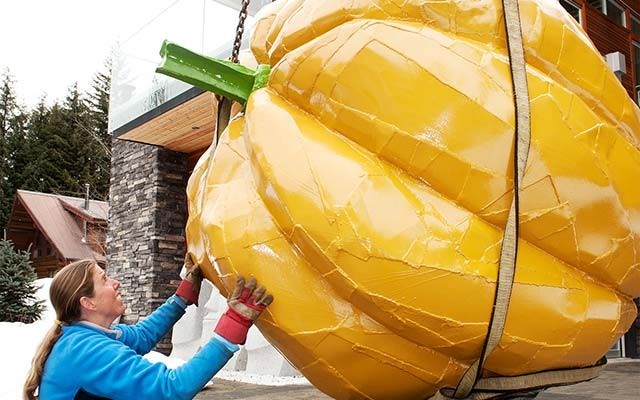You can see it from the road in White Gold.
Whistler steel sculptor Christina Nick has just delivered her latest project. A privately commissioned, two-metre high pumpkin that weighs around 180 kilos.
A pumpkin? It's out of season. It's spring. What is that all about?
"A collector of large sculptures, he just thought it would be cool. I am pretty sure he saw something like it in Japan," Nick says of her buyer, who wishes to remain anonymous. "I threw a proposal together and he said 'sure, let's do it.'"
Nick, who has lived in Whistler since 1990, is known for her to-scale welded animals. She has done everything from life-sized crows, to horses, to giraffes.
She has been the artist-in-residence at the Brackendale Art Gallery in Squamish since 2004.
A pumpkin was a little out of her comfort zone, she says.
"It took so much longer than I expected. It took about three months. It was complicated... I don't usually do things that don't have legs!" she says. "It was my first vegetable. I was really reluctant to do it, because it was a subject I would have never chosen myself. Ultimately, there are a lot of surprises with the sculpture now. It's funny, there I things I've never seen in any of my other sculptures."
And it grew, as pumpkins tend to do.
"I started working on it and my proposal was about half the size it turned out. I don't know. Things get bigger; I don't have that much control sometimes over things in the studio. It just got huge," says Nick. "I knew that he likes big things, so that was kind of a subconscious choice. Ultimately, it's perfect. Where it is, it would have looked kind of silly if it were any smaller.
"It's on the side of the house above the parking lot and above the road, and it looks like it's going to roll down. The way it's place and the way the landscaping is, it's a really angsty sculpture. It's cool. I never expected that!"
The new owner had only seen photos as it was being built. Delivery day was the big reveal.
"Pumpkins can grow really big, though they can never grow that big. So that's why it's better than my original plan and he loves it," Nick says.
"There's a confusion with scale. The pumpkin is an abnormally large vegetable, but the house is really big, so it fits. But when you put people or cars in the driveway, it's just this weird scale thing that really makes you look twice.
"That's not something I ever had before. I've made big sculptures, but the scale would be it's a giraffe and giraffes are big. But this is dealing with exaggeration and makes the viewer feel things that are unexpected."
And then there was the colour.
"I've never painted a sculpture before. One of the reasons I don't paint my sculptures is that I like to be really honest with the material. I really like steel and I like that it changes, the patina you get, and all that," Nick says.
"When I knew I was going to have to paint this sculpture, I was a little hesitant, but then I started thinking that it would be an interesting way of working. And it was. Physically applying the paint sucked, because it's so toxic. But it's apparently the bomb for covering steel; it stops rust forever, and flexible, and never scratches off.
"I chose an industrial yellow, because I didn't want it to be too much like a Jack-o'-lantern. I wanted it to be a more ambiguous squash-pumpkin idea. But that's cool, too, because it's the colour that bulldozers are painted... an organic vegetable is actually the colour of a bulldozer."
The project took Nick down a creative path that she ended up liking because it challenged her skills.
"It made me think!" She says.
"It's funny because I didn't think of it that way until it was in place. There are a whole bunch of things that were interesting. At first, you think 'I'm going to make a pumpkin?' It's almost ridiculous but, actually, it's kind of cool."
Nick also works as a bike guide for Canadian touring company Butterfield and Robinson. Nick noted that their fastest growing sector is custom-made trips, and felt it tied into custom-made work in her art. She thinks there might be a trend.
"The past four or five years has been interesting because I've been able to go from commission to commission. Prior to that I never really had them, for some reason there was a tipping point. The 2008 recession happened, and the result for me was that galleries were closing and I was losing my chance to exhibit in commercial galleries. Eighty per cent of the galleries I showed in shut their doors. But the other result is that I started to get these commissions," she says.
Soon, Nick is off to France, where she works for several months each year. She is planning a show in a gallery in the town of Nay in 2015. And she will be visiting Newfoundland first, to work on a project there.




